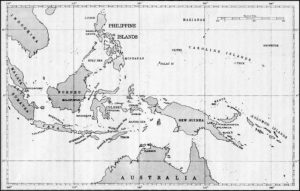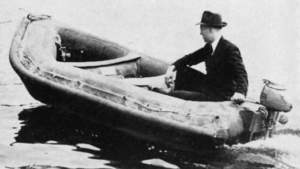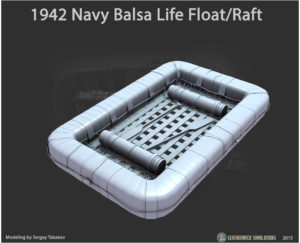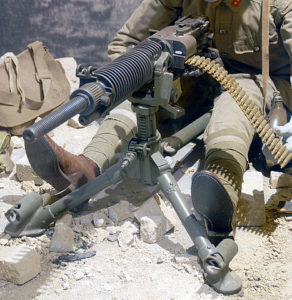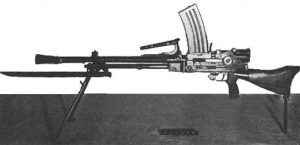Recently, I’ve been looking into L. Ron Hubbard’s claims regarding his military career as a US Naval Reserve intelligence officer in the Pacific theatre early in WWII. I was curious as to the contexts of these claims, given the variances in accounts from Scientology historians such as Chris Owen, Jon Atack and Jeffrey Augustine. The Scientology Myths website also provides an excellent resource for source documentation regarding Hubbard’s naval service, as well as his brief time in the Marine Corps Reserve, though with a distinctly revionsist position as to Hubbard’s claims. While I’m interested in Hubbard’s brief Marine Corps service and will be examining that in the future, in this, the first of a multi-part series, I’ll be deconstructing his claims as to having been involved in espionage against the Japanese on Java in 1942. Future posts will look into his role as an intelligence officer in Australia from 1942 onward, as well as his postwar service and hospitalization.
My purpose here is to add to the existing body of research on the matter, by bringing my service background and life-long interest in military history to bear. The Pacific Theatre is of great personal interest to me, as my father served there as a Naval aviator. Indeed, his stories and those of friends and family, along my own reading on the subject, engendered a great deal of respect for those who fought in the Pacific, and were all significant motivators in my joining the Marine Corps. In revisiting Hubbard’s record, I hope to provide some useful additional context regarding his claims, and in doing so, further expose the exaggerations and outright lies of Mr. Hubbard in regards to his service early in WWII. For the most part, Hubbard served his country honorably in a time of war; it’s his exploiting his time in the Navy to further Scientology, as well as embellishing his service record, personal decorations, and overall contribution to the war effort that I find repellent.
Hubbard Joins Up
While Hubbard is an incredibly complex individual, his early adulthood reflects a consistent thirst for adventure, wherein he demonstrated surprising competence in a variety of disciplines. He certainly never wanted for self-confidence, however misguided his bravado may have been given the particular circumstance. To me, this sense of adventure and bravado is what drove his literary career and would later manifest itself in his fantasist exaggerations and warped sense of destiny, as reflected in Excalibur and later, his bombastic claims regarding his service in WWII. The son of a Naval officer, it was inevitable that these traits would eventually coalesce in Hubbard attempting a military career at some point, and thus the rise of totalitarianism in Asia and Europe in the 1930s provided him with the entré to do so. However it was not an easy journey, as he was rejected by the Army, the Army Air Corps, and initially by the Navy, and after a short stint in the Marine Reserves, was honorably discharged, through with the proviso that he would never be allowed to reenlist.
The record shows Hubbard endured a rather tortuous path to his eventual commissioning in the US Navy Reserve; one of several complete narratives of Hubbard’s military enlistment odyssey can be found here. Hubbard pulled out all the stops he felt necessary to join the Navy, and would go on to solicit a letter of recommendation from his congressman, Warren G. Magnuson, who was fortuitously at the time, a member of the Committee on Naval Affairs. The circumstances of Magnuson’s recommendation hint that Hubbard may have indeed forged his and other letters of recommendation, given the rather florid, hagiographic nature of the prose; he bombarded anyone he thought could be influential in furthering his aims, even to the point of including a variety of wacky schemes and policy suggestions in supporting his suitability to serve. Despite this broad effort and rather impressive pool of supporters, Hubbard’s budding naval career failed at the first hurdle, as he failed his enlistment physical on medical grounds for poor eyesight.
Hubbard’s salvation proved to be President Franklin Roosevelt’s declaration of an “Unlimited National Emergency” on May 27, 1941 as a result of Germany’s unrestricted U-boat warfare in the North Atlantic. This declaration resulted in huge expansion of the armed forces, made all the more urgent by the sorry state of the military at the time as a result of American isolationism, thus the Navy was in dire need of line officers to fill specialized billets (jobs), especially in intelligence. Hubbard’s acceptance into the ranks was not auspicious, given the observations of Commander Lucious Dunn, the intelligence officer at the Washington Navy Yard who approved Hubbard’s commissioning:
“Although the subject Applicant is deficient in academic educational background, it is considered that his professional experience in newspaper work and travel compensates for his deficiency in the academic.”
It’s important to understand the nature of Hubbard’s commission as it relates to his intelligence qualifications and his eventual claims as to his duties in Java and Australia. Hubbard was commissioned as Lieutenant J.G. (junior grade), with a reserve classification of I-V(S) (or Intelligence Volunteer – Specialist). Per the Code of Federal Regulations in place at the time, the role and responsibilities for I-V(S) officers and enlisted men were “assigned thereto, in accordance with such instructions as may be issued from time to time, organized by zones and subzones established by Commandants of the naval districts for the purposes of instruction and training in accordance with the policy and authority of the Chief of Naval Personnel and the Chief of Naval Operations.”
Hubbard as Intelligence Officer
In essence, what this means is that Hubbard was to be trained “on the job” rather than formally educated as an intelligence officer, as the Office of Naval Intelligence (ONI) had yet to develop the concept of a “professional” intelligence officer, nor the means to educate them as a distinct specialization. The “specialist” designation simply means that a member may occupy a specific billet within an intelligence organization, not that one is a “covert operator” or the like, as the Church of Scientology would later claim. In my opinion, the misinterpretation of this simple annotation is responsible for much of the confusion, dissimilation and fraudulent misrepresentation of the circumstances surrounding Hubbard’s actual intelligence role.
Professional naval officers, such as those graduating from the Naval Academy at Annapolis or commissioned direct from the nation’s universities, when compared to reservists such as Hubbard, learned about intelligence as part of their general war fighting education, more so, as it related to developing war plans and enemy order of battle, as well as more prosaic duties such as censoring outgoing mail. In the 1920s, the use of cryptography or “signals intelligence” as a means to obtain intelligence was coming to the fore. It was from the ranks of these early cryptographers and analysts, collectively known as “OP-20G” (Office of Chief Of Naval Operations [OPNAV], 20th Division of the Office of Naval Communications, G Section/Communications Security), that the nucleus of a of professional intelligence officer corps would emerge prior to WWII. The importance of signals intelligence in the early days of WWII cannot be overstated, as OP-20G’s breaking of several key Japanese naval and diplomatic codes before the war bought precious time for US forces in the Pacific to recover from the early defeats of 1941. OP-20G’s capabilities were key in determining the outcome of the Battle of Midway during June 4-7 of 1942, wherein US Navy carrier aviation was able to sink 4 Japanese carriers, resulting in the first major Japanese setback of the war.
Prior to the founding of the Office of Strategic Services (OSS) on June 13th, 1942, the precursor to the Central Intelligence Agency (CIA), intelligence gathering was spread across the Departments of State and Treasury and the FBI, along with the War Department. Foreign correspondents from the major US daily newspapers were informally co-opted as well to provide timely information. However, the majority of “in-country” intelligence gathering was done by naval or army attachés attached to either specific military missions or US embassies across the globe. Much of what these attachés collected was “open source,” in that it was intelligence readily available in newspapers, technical journals, or trade shows. Attachés were also encouraged to develop personal relationships with their peers in host nation navies, as well as using their own initiative to visit sensitive military sites or to make clandestine arrangements to obtain sensitive or secret information where necessary. It was in this role of naval attaché and later, as a naval “observer,” that Hubbard would flirt with any sort of formal intelligence role while in the Pacific.
Hubbard would initially not fill an actual intelligence billet for sometime, instead, having been ordered to New York to work in public relations and recruiting, given his background as an author. His pre-war 1940 Alaskan radio navigation expedition provided fodder for yet another diversion, as he was allocated to the Navy’s Bureau of Navigation Hydrography office in Washington DC. Here it appears he also took an intelligence course from Oct. 21st to Nov. 11, 1941, (the content of which is unrecorded), in addition to being tasked with annotating and mounting the photographs he’d taken during his Alaskan trip. Upon completing this rather mundane tour of duty, was released from active duty on or about November 1, 1941. He then returned to active duty on the 24th of November, two weeks before the Japanese attack on the US Pacific Fleet at Pearl Harbor on December 7th.
Hubbard was then assigned to the 12th Naval District headquarters’ intelligence section in San Francisco, arriving on or about December 2nd. Naval records show that he then sailed on the transport vessel USS Polk, as part of a relief convoy with aircraft and troops destined for the Philippines. Known as the “Pensacola Convoy,” after its flagship, the heavy cruiser USS Pensacola (CA-24), the convoy would eventually be re-routed to Brisbane, Australia, as a result of Japanese dominance of the sea lanes around not only the Philippines, but also those dangerously close to Northwestern Australia.
Hubbard as spy: the Myth and the Reality
It’s in this late 1941 to early 1942 timeframe that the first of the many great myths of Hubbard’s service in the Pacific originates, that of having spied on Japanese forces on Java. The primary source for this story is court testimony by Capt. Thomas Moulton in 1984. Jon Atack provides a brief summation of Moulton’s testimony, which I’ll then deconstruct claim by claim:
“In 1984, Captain Thomas Moulton testified in court as a witness for the Scientologists. Moulton had served briefly with Hubbard, and expressed a deep admiration for him. Moulton recounted another of Hubbard’s claims of military prowess that the Scientologists probably had not expected.
According to Moulton, on the day the Japanese attacked Pearl Harbor, Hubbard ‘had been landed, so he told me, in Java from a destroyer named the Edsall [misspelled “Edsel” in the Court transcript] and had made his way across the land to Surabaja …. When the Japanese came in, he took off into the hills and lived up in the jungle for some time …. He was, as far as I know, the only person that ever got off the Edsall ….She was sunk within a few days after that.’ Hubbard had allegedly been a gunnery officer on the Edsall.
Hubbard also told Moulton that he had been hit by machine-gun fire, “in the back, in the area of the kidneys …. He told me he made his escape eventually to Australia …. He and another chap sailed a life raft… to West Australia where they were picked up by a British or Australian destroyer… on the order of seventy-five miles off Australia …. It was a remarkable piece of navigation.”
A remarkable piece of navigation indeed. But let’s start from the top, specifically where Java, the Japanese, and the USS Edsall all play into this tale. It’s important to remember that for all the importance the United States place on its presence in Asia, the Philippines in particular, the lean defense budgets of the interwar years had ensured that much of America’s overseas presence was very much a hollow force.
The Claims: The Japanese, Java, and the USS Edsall
Beset by inter-service rivalries, obsolete equipment and poor strategic planning, the US Navy’s Asiatic Fleet at the beginning of WWII was no match for the naval prowess of the modern, highly capable and highly trained Imperial Japanese Navy (IJN), nor was the US Army able or indeed willing to entertain a combined operations approach in dealing with the Japanese onslaught in the Southwest Pacific. Further aggravating this interservice discord was the complicated command relationship amongst American and British, Dutch and Australian (“ABDA”) naval forces that would eventually comprise any effective allied response in and around Australia, Java, and other strategic areas threatened by the IJN.
The Clemson-class destroyer USS Edsall (DD-219), was perhaps a microcosm of all that was wrong with not only the Asiatic Fleet, but the pre-war US Navy in general. Her crew, while highly trained and motivated, were at the mercy of an apathetic if not incompetent local command structure; they were beset by problems with ammunition and weaponry that was often obsolete or defective, while on a ship that was built during WWI, and their location at the absolute end of an already extremely tenuous supply chain made for an overall poor state of combat readiness. Here’s the USS Edsall as she appeared in the 1920s: 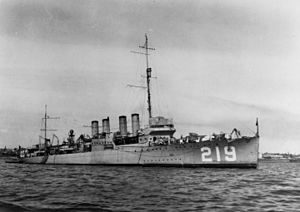
When coupled with this lack of command urgency, suspect tactical acumen, and tenuous logistics, the fleet’s relative isolation ensured that Edsall and her sisters were operationally doomed from the start. What was even more distressing is that while Pearl Harbor was America’s naval power showcase in the Pacific, it was the aging, ragtag Asiatic fleet that would be the first line of defense against the Japanese post-Pearl Harbor. The Asiatic fleet’s main offensive surface capability comprised only one heavy and one light cruiser, with its remaining offensive capability made-up of obsolescent submarines, destroyers, gun boats and support craft. While its sailors retained a high degree of pride, professionalism and skill, they realized that they’d be hard pressed to prevail in a surface action against the IJN, and as a result, fought with the tenacity of the damned.
The official records show that Hubbard was still stateside when the Edsall sailed in harm’s way from its port of Balikpapan in Borneo on December 8th, 1941; he finally arrives in Brisbane on January 11, 1942 unattached to any specific command (more of which we’ll relate in Part 2). In attempting to reconcile Hubbard with the Edsall, a key fact is that her only Australian port of call was Darwin in early January, as part of her duties included escorting convoys in northern Australian waters to and from Java. Significantly, the official record shows no mention of any officer or crew replacements during her brief stay. She would go onto fight in several major surface engagements, including participating in the war’s first sinking of an enemy sub, until she herself was finally sunk by the IJN cruiser Tone on March 1st, 1942. So outside of the fact that Hubbard was on the other side of Australia, there is no official record of him ever being assigned to the Edsall. For argument’s sake, let’s examine the viability of his spying claims individually:
“According to Moulton, on the day the Japanese attacked Pearl Harbor, Hubbard “had been landed, so he told me, in Java from a destroyer named the Edsall [misspelled “Edsel” in the Court transcript] and had made his way across the land to Surabaja ….”
On December 8th, (December 7th west of the international date line), the Edsall was in her port of Balikpapan, 734 nautical miles north of Surabaya; Moulton says Hubbard “made his way across the land to Surabaja (sic);” so where did he sail from? As Surabaya’s a port city, why not just drop Hubbard in the vicinity, rather than sailing to the opposite side of Java and forcing him to cross the entire island, given that Surabaya is located on the side of Java closest to Balikpapan? Moulton never mentions Hubbard being anywhere near Borneo, let alone departing from there on the Edsall for a spying mission on Java. Keep in mind that the distances I’ll be referring to reflect the vastness of the Southwest Pacific as seen in this map:
Let’s now look at how hard it would have been for Hubbard to have “made his way across the land.” At the time that Hubbard was supposed to have been in Java, Surabaya was the largest city in the Dutch East Indies, located in the lowlands of East Java province. He would have been there in December during the rainy season, where the average daily temperature is in the mid-80s Fahrenheit and the daily rainfall almost 9 inches, with 79% humidity. Given this is all fiction anyway, we have no idea from where Hubbard would have begun his trek to Surabaya, so we’ll guess he landed on the southern shore of the island, given that was closest to the last known position of the USS Edsall.
We know that at the time, Hubbard had no formal military jungle survival or land navigation training to speak of, though he most likely could use a map and compass. However, given his poor eyesight and probable low fitness level, I doubt he’d have ever have been able to undertake a leisurely long hike in such conditions, let alone a stealthy escape and evasion route through the jungle on the island’s southern side, and then, without being detected, cross the largely wide-open low land environs of Surabaya.
“When the Japanese came in, he took off into the hills and lived up in the jungle for some time …. He was, as far as I know, the only person that ever got off the Edsall ….She was sunk within a few days after that.” Hubbard had allegedly been a gunnery officer on the Edsall.”
Again, the crew roster shows no record of Hubbard ever setting foot on the USS Edsall, let alone serving as her gunnery officer or surviving her sinking. Japanese records show that they rescued only 6 survivors out of her crew of 153. However, none of these survivors survived the war, having been eventually executed by the Japanese and their bodies recovered after the end of the war. More so, the Japanese landings on the northeastern coast of Java began on February 28th, 1942, the day before the Edsall was sunk by the Tone, some 300 nautical miles southwest of Hubbard’s supposed hideout near Surabaya; again, we are reminded that as a supposed survivor of Edsall’s sinking, in addition to escaping Japanese captivity, there is also the question of his ability to “live in the jungle for some time…”
Then there’s the significant logistical considerations of Hubbard’s alleged spying mission. First off, why use a scarce, valuable surface combatant resource like the Edsall for a solo spy mission? More’s the point is that a large warship is hardly the ideal platform for a covert insertion, given their draft when close to shore, their high profile, and other handicaps. Why not use one of the Asiatic fleet’s 29 submarines that were available at the time, or a PBY Catalina float plane, given the need for a stealthy insertion into “enemy held” territory? So aside from these key considerations, how did Hubbard get from the Edsall to shore?
Moulton appears to imply that Hubbard used a life raft or something similar as a means to infiltrate the Javanese shoreline, (“had been landed”) and further states Hubbard specifically used a life raft to later escape from the Japanese. Yet this is patently absurd, given a life raft is meant as a temporary means to ensure survival from a sinking ship or ditched aircraft, rather than as a deliberate form of tactical or covert transportation. More so, the complications of using any sort of inflatable craft in even light surf without any formal training are considerable; as a Marine, I spent a lot of time using large IRBs (inflatable Rubber Boats) and Zodiac rigid hulled raiders, and even with our extensive training in a variety of challenging conditions, there were always mishaps and complications due to the ocean’s unpredictability, especially at night. There’s just no way an untrained and unfit individual with poor eyesight would be able to pull this off without being incredibly fortunate…
Given that Hubbard was supposedly unaccompanied during his mission, doctrine would call for the use of a LCRS (Landing Craft Rubber, Small), a purpose-built inflatable boat for tactical insertion:
Contrast this with your typical balsa wood naval life raft then in use across the Navy at the time, and the absurdity of the proposition becomes even more clear:
There’s no mention of what sort of equipment or weaponry he took, nor just exactly what the purpose and duration of his mission was, outside of “spying.” Did he live off the land while “he took off into the hills and lived up in the jungle for some time”? Troublingly, if he was supposed to be spying on the Japanese, why did he flee into the hills, (ignoring the fact that the Japanese hadn’t even invaded during the time Hubbard was supposedly on Java)?
The next claims are perhaps the most ludicrous of those regarding his role as spy:
“Hubbard also told Moulton that he had been hit by machine-gun fire, “in the back, in the area of the kidneys …. He told me he made his escape eventually to Australia …. He and another chap sailed a life raft… to West Australia where they were picked up by a British or Australian destroyer… on the order of seventy-five miles off Australia …. It was a remarkable piece of navigation.”
Never mind the fact that he was never even near Japanese troops armed with machine guns, his ability to survive being shot in the lower back and kidneys is beyond belief. Japanese infantry at the time were armed with bolt-action Type 99 Arisaka rifles and crew-served medium or heavy machine guns chambered in the 7.7×58 rimless cartridge; ballistically similar to the English .303 calibre rifle cartridge, the 7.7 round was extremely lethal, certainly when delivered at 450 rounds per minute (RPM) by a Nambu Type 92 heavy machine gun:
Or at 700 RPM by a Type 99 light machine gun:
Hubbard would have been most likely almost cut in half by the destructive kinetic energy of either weapon; at a minimum his lower spine, pelvis and kidneys would have been shredded, critically wounding him, if not killing him outright. I have read enough accounts by Marines who encountered both weapons in the Central Pacific’s savage island fighting, to know that one could survive being hit in the extremities by machine gun fire, but not in the vitals, especially when targeted by a highly competent Japanese gunner, as would have been the case early in the war.
We then move onto his departure from Java, ostensibly as a result of the Japanese invasion. In regards to his having escaped to Australia, I’ve not been able to establish who this “other chap” was who allegedly accompanied him, though it’s inconsequential, as his reported 1115 nautical mile voyage to safety is yet more fiction. Suspending disbelief yet again, I’ll try and flush out Moulton’s vague recollections in this regard.
First, there’s no mention of how Hubbard meets this unknown accomplice, nor how they both manage to escape from Java. We’ll assume they indeed obtained a life raft, complete with oars and a sail, and made their way toward Western Australia, navigating by the stars or perhaps Hubbard’s pocket compass from his cross-Java excursion. Why not locate a more suitable craft, such as a small boat? If he was a competent spy, you’d think he and his controllers would have arranged for pick-up via sub, aircraft, or other contingency, rather than attempting such a fool hardy sea journey in heavily patrolled Japanese-held waters.
There are numerous examples of downed airman and shipwrecked sailors successfully navigating significant distances in rafts and small boats and being rescued during WWII. The physical and mental toll was considerable; more so, it required a great deal of prior survival training, skill, fortitude and luck to do so, and while Hubbard was an accomplished sailor, surviving and navigating the open ocean in a raft is a whole other proposition than sailing the inland passage to Alaska. Finally, his serendipitous rescue by an Allied destroyer just reinforces the improbability of the whole tale, given the size of the Java sea off the shore of Western Australia, as well as the lack of any Japanese intervention during his odyssey, knowing that they enjoyed both air and sea superiority at this time.
In Conclusion
We have Hubbard’s medical and service records, neither of which make any reference to his being wounded during a clandestine operation in Java, nor in any sort of combat during the war for that matter. The reality is that he was in New York and then in transit to Brisbane during the time he was allegedly snooping around Java, and once in Brisbane, was involved in further attempts to gold plate his war experiences, as well as again demonstrating that his own opinions as to his value as an intelligence officer were far removed from those in command.
In Part 2, we’ll look at Hubbard’s Australian escapades and again attempt to deconstruct the nature of his service there, and how it would set the stage for his eventual return stateside.
